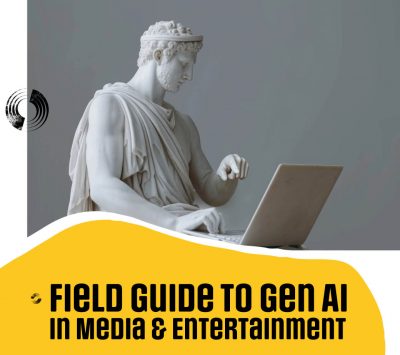In this week’s fxpodcast, we sit down with Alexandru Costin, head of Adobe’s Firefly generative AI team, to discuss the evolution of generative AI, Adobe’s unique approach to ethical content creation, and the groundbreaking work behind Firefly.
 This podcast is not sponsored, but is based on research done for the new Field Guide to Generative AI. fxguide’s Mike Seymour was commissioned by NVIDIA to unpack the impact of generative AI on the media and entertainment industries, offering practical applications, ethical considerations, and a roadmap for the future.
This podcast is not sponsored, but is based on research done for the new Field Guide to Generative AI. fxguide’s Mike Seymour was commissioned by NVIDIA to unpack the impact of generative AI on the media and entertainment industries, offering practical applications, ethical considerations, and a roadmap for the future.
The Field Guide is free and can be downloaded here: Field Guide to Generative AI.
From GANs to Multimodal Models
As you will hear in the fxpodcast, Adobe’s journey with generative AI began in 2020, when Adobe introduced Neural Filters in Photoshop. At the time, the focus was on using GANs (Generative Adversarial Networks) to generate new pixels for creative edits. Today, Adobe’s scope has expanded dramatically to include Diffusion Models, Transformers, and cutting-edge architectures.

“For me, the core principle of generative AI hasn’t changed—it’s about the computer understanding user intent and synthesizing responses from training data,” Alexandru explains. “The models have evolved to not only understand and generate text but also create and enhance images, videos, audio, and even 3D assets.”
Adobe is uniquely positioned in this space, as its product portfolio spans nearly every creative medium. With Firefly, they’ve embraced multimodal generative AI to create tools that cater to text, images, audio, video, and beyond.

Firefly
Firefly is Adobe’s flagship generative AI platform, now integrated into industry-leading tools like Photoshop, Illustrator, and Premiere Pro. According to Alexandru, Firefly’s strength lies in its training data: “At its core is a set of high-quality data we have the right to train on. That’s what sets Firefly apart—it’s both powerful and safe for commercial use.”
One standout feature is Photoshop’s Generative Fill, which Alexandru describes as a “co-pilot for creatives.” Users can guide Photoshop with text prompts, allowing Firefly to generate precise visual results. The technology has democratized generative AI, making it accessible and practical for VFX professionals and enthusiasts alike.
Ensuring Ethical AI
Adobe has been a staple of the creative community for over four decades, and with Firefly, they’ve prioritized respecting artists’ rights and intellectual property. Alexandru points to Adobe’s commitment to “clean training material” as foundational to Firefly’s strategy.
“We’ve implemented guide rails to guarantee that Firefly won’t generate recognizable characters, trademarks, or logos,” he says. This safeguard ensures that users’ work remains free from unintentional infringement—a critical consideration in the commercial space.
The C2PA Initiative: Building Trust in Media
One of Adobe’s most significant contributions to the generative AI landscape is its leadership in the Coalition for Content Provenance and Authenticity (C2PA). Launched in 2018 from Adobe Research, the initiative addresses the growing concern around misinformation and content authenticity.
“Think of it like a nutrition label for digital media,” Alexandru explains. “The goal is to provide transparency about how a piece of content was created, so users can make informed decisions about what they’re consuming.”
The initiative has attracted over 3,000 organizations, including camera manufacturers, media companies, and AI model creators. By embedding content credentials into outputs, the C2PA aims to establish a universal standard for verifying authenticity—a crucial step as generative content continues to explode.
Looking Ahead
As the generative AI landscape evolves, Firefly represents Adobe’s commitment to balancing innovation with ethical responsibility. By building tools that empower creators while protecting intellectual property, Adobe is aiming to build a future where generative AI becomes an indispensable part of creative workflows.
Join us on this week’s fxpodcast as we dive deeper with Alexandru Costin into the future of generative AI, Adobe’s strategic plans, and the lessons learned along the way.





